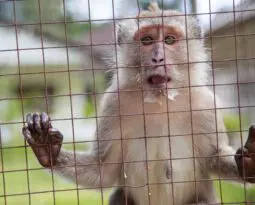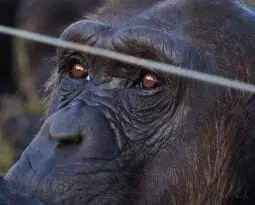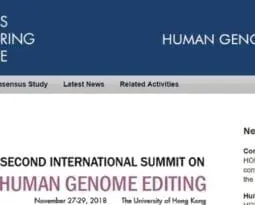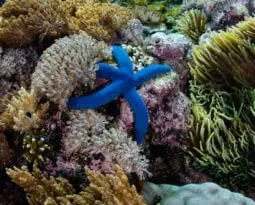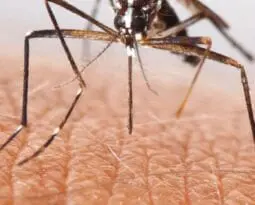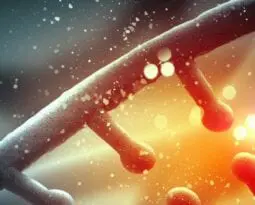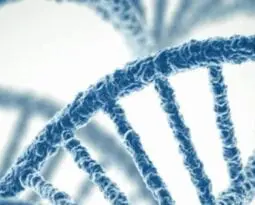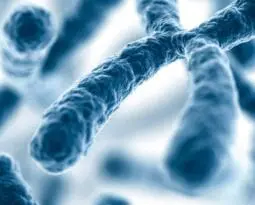Ethics of Nature, Human Nature, and Biotechnology
Selected resources from The Hastings Center.
Bioethics Briefings:
Nature, Human Nature, and Biotechnology
Moral views about nature—claims that nature or a natural state of affairs has value—are important in contemporary debates about biotechnology. Bioethical issues regarding nature draw on environmental ethics, public health, and animal ethics. Three kinds of biotechnological interventions involve moral views about nature: alterations to human nature, alterations to plants and animals in human settings (such as agriculture, industry, and the home), and alterations to wild organisms in the shared environment. Read our briefing to consider: how can one incorporate moral views, stemming from different opinions and belief systems, about nature in public policy?
From Hastings Bioethics Forum:
- Catastrophe Ethics and Charitable GivingHow can we live a morally decent life in a time of massive, structural threats that seem to implicate us at every turn? Climate change is the paradigm example. Am I permitted to fly? Should I buy an electric car? Go vegan?
- Involuntary Donation: Animal Welfare and XenotransplantationThe realized promise of xenotransplantation seems to be quickly approaching, following the medical breakthrough of a pig kidney functioning for a record two months in a deceased human body. This milestone has received overwhelmingly positive media attention. Ethicists, physicians, and transplantation specialists have shared their apprehensions about the risks of implanting animal-grown organs into humans. However, conspicuously absent from these discussions is a major stakeholder: the animals.
- Philanthropy is Not Enough: Oil and Gas Giants Must Consider Medical EthicsGiven the well-known environmental and health risks of oil and gas drilling, oil and gas giants that enter developing nations routinely offset these risks with charitable investments. Are these investments sufficient? Do the funds go where they are needed? Answering this question raises ethical issues that need greater attention.
- Primates in Medical Research: A Matter of Convenience, not Sound ScienceWhat are the current and future potential uses of nonhuman primates in research? The National Academies of Sciences, Engineering, and Medicine is examining this question.
- An Evergreen Metaphor: Strachan Donnelley, Dan Callahan, and Environmental EthicsThe devastation of Hurricane Ida and the global threats of climate change are not on the fringe of bioethics. They call to mind the language of priority-setting typical of bioethics discourse. Who lives and who dies? What can be accomplished with prevention and more levees? And if more are built, how do we set priorities with limited resources?
- The Elephant from Heaven and the Chicken from Hell–or: Colossal FantasiesI have always wanted to see a woolly mammoth. From the time I first read about them up until, well, a few moments ago, I’ve fantasized about going back in time to see a herd shoving its way through an Ice Age snowstorm. Alas, it cannot be, even if George Church and a new company, Colossus, bend heaven and earth to make it happen.
- What Is Ethical Eating in the Age of Climate Change?Are we ethically obliged to eat less meat? Bioethicists consider that question, and their role in addressing it.
- Not-So-Golden Years for NIH’s Retired ChimpanzeesThe National Institutes of Health recently announced that it will retire-in-place the remaining 44 chimpanzees at the Alamogordo Primate Facility in Alamogordo, New Mexico, rather than transfer them to a sanctuary as originally planned. NIH’s decision is disappointing for those who believe that the chimpanzees—many of whom have spent decades in research—should experience the freedom and quality of life a sanctuary would provide.
- Hannah Arendt in St. Peter’s SquareNeither one of us expected to be talking about Hannah Arendt at the Vatican. We had been invited to give talks at the Pontifical Academy of Sciences on the scientific and ethical challenges posed by personalized medicine. Walking across the cobblestones of St. Peter’s Square we began to discuss how society regulates biomedical research. Are institutional review boards capable of dealing with innovations like personalized medicine? Are they too bound by regulations? Can they ask larger questions of meaning when simply following the rules won’t suffice? And most worrisome, has their bureaucratic function caused them to mistake regulatory compliance for ethical reflection?
- Living Good and Healthy Lives on a Changing Earth: What Should Bioethics Do?What does it mean to live well on a warming planet? And as the climate changes, how might health care, education, and other sectors support, or obstruct, our ability to respond? The answers to these profound, and profoundly bioethical, questions will critically influence human well-being in this century and beyond. A group of scientists, educators, and bioethicists convened at The Hastings Center recently to consider these questions and begin an interdisciplinary conversation on how bioethics might address the challenges posed by climate change.
- We Should Be Concerned About Athletes Having to ‘Dope Down’The Court of Arbitration for Sport has decided that female athletes with atypically high levels of testosterone must take testosterone-lowering medication in order to compete in certain events. I’m troubled by the precedent this sets.
- Caster Semenya and the Challenges of Sports BracketsIf virtuous perfection of natural talents is what sports is all about, sports needs more people like Caster Semenya, the South African runner. But she is now ineligible for competing in middle distance events unless she takes medication to suppress her naturally high testosterone levels. Is this fair?
- Rationality as Understood by a NeanderthalThe new indie movie William explores the question, What would it be like if a Neanderthal were born and raised in a modern, industrialized society today?
- Should We Edit the Human Germline? Is Consensus Possible or Even Desirable?I started writing this on my way back to New York from the Second International Summit on Human Genome Editing, held in Hong Kong November 27 to 29,…
- The Only PhD Scientist in Congress Speaks About Truth, Politics, and Human FlourishingAt a time when facts are distorted, disregarded, and ignored in policy making and political discourse, the need in Washington for seekers and defenders of truth has perhaps…
- Might Chimpanzees Have Legal Rights?On May 8, the New York Court of Appeals denied an appeal to have two captive chimpanzees, Kiko and Tommy, recognized as legal persons with the right to…
- Chimpanzees: Persons or Things?Last month, a group of 17 North American philosophers (myself included) filed an amicus curiae brief with the New York State Court of Appeals on behalf of Kiko…
- Fix the Planet, or Change the Creatures In It?Possibly as many as half of the coral reefs that existed 100 years ago have been destroyed, sometimes by removing them, covering them up, or blowing them up,…
- Is it Ethical for Scientists to Create Nonhuman Primates with Brain Disorders?In early 2016, Nature published a letter from a group of Chinese researchers reporting that they had created rhesus macaques with “autism-like” behaviors. The macaque was bred with…
- The Climate Agreement: Understanding, and Leveraging, Public OpinionAfter years of fluctuating and troubled efforts, the nations of the world in December of 2015 came to the remarkable agreement to work together to reduce global warming….
- Missing from NIH Primate Research Ethics Review: the EthicsScientists acknowledge biological, behavioral, and psychological similarities between human and nonhuman primates; hence their use as proxies in biomedical research. At the same time, primates are denied many…
- Being at Two with Nature and MosquitoesWhen Woody Allen said he was “at two with nature,” perhaps he had in mind insects that sting or bite. Who can argue with that, and who hasn’t…
- Challenging Evolution?We have long had the ability, we humans, to work outside the bounds of evolution. Dairy cattle, maize, and all sorts of dog breeds attest to that. It…
- Are Arguments about GMO Safety Really About Something Else?The scientific consensus that food containing genetically modified organisms is safe seems ever stronger, yet the social controversy about GMOs seems only to grow as well. “Unhealthy Fixation,” a long…
- On a Radioactive Pig and Pope Francis“If you look through the red-tinted glass, you will see the radioactive pig,” said the director of animal laboratories at my university–let’s call her Susan–near the start of…
- Rats Have Empathy, But What About the Scientists Who Experiment on Them?Decades of experiments have shown that rats are smart individuals that feel pain and pleasure, care about one another, can read others’ emotions, and will help unfamiliar rats even at…
- New in Skin Care: Natural and GMOAt the end of April, the biotech firm Amyris announced that it was launching its own line of skin emollient under the brand name Biossance. The product is…
- Sacred versus Synthetic? Nature Preservationism and BiotechnologyOne of the long-term contributions of Earth Day is that it offers a regular, semi-official reminder that a sense of the sacred is a vital part of environmentalism….
- A Moratorium on Gene Editing?An article in the New York Times last week suggests that the genetic engineering of humans is only just around the corner. A recently developed gene editing tool…
- GM Mosquitoes: Risks and EmotionsFor several years, a British company called Oxitec has been proposing a strategy for controlling a species of mosquito, Aedes aegypti, that humans have accidentally carried from Africa…
- Altering Nature to Preserve ItPerhaps the biggest challenge in talking about something like de-extinction is simply being clear on what it is you’re really talking about. Emerging technologies can be surrounded with…
- OHRP’s Dangerous Draft GuidanceIn October, the federal Office for Human Research Protections issued a “Draft Guidance on Disclosing Reasonably Foreseeable Risks in Research Evaluating Standards of Care.” It follows the controversy that erupted…
- Synthetic Biology: A Study in ReinventionAn article in the October issue of Discover Magazine has a great line from Drew Endy, a bioengineer at Stanford University who has become one of the foremost public figures in the…
- Nature Isn’t What It Used To BeIs the end in sight for wilderness? A recent opinion piece in the New York Times, by the science journalist Christopher Solomon, says it is. “There’s a heresy echoing through America’s…
- Synthetic ChromosomesA team of scientists announced this week that it had successfully created one of the sixteen chromosomes found in yeast cells, marking a meaningful step forward in that…
- What’s at Stake with Genetically Modified OrganismsA remarkable set of essays appeared recently in Grist, a nonprofit dedicated to “dishing out environmental news and commentary,” about the warring claims over genetically modified organisms. In the inaugural…
- De-Extinction: Could Technology Save Nature?This past November, the International Union for the Conservation of Nature declared the western black rhinoceros of Africa, last seen in 2006, officially extinct. It also concluded that…
- The Push for Data Transparency and Implications for ResearchSome of the most hotly debated questions making the rounds these days include who should interpret, distribute, review, and receive data, and with good reason. From WikiLeaks to…
- Support for Returning Results of Alzheimer’s Disease Biomarker ResearchThis used to be a purely academic question: If you could know, years before you had symptoms of Alzheimer’s disease, that you were likely to develop it–and there…
- As Chimp Research is Phased Out, Will Other Animal Research Decline?The institution of animal experimentation is a house of cards, and a stiff wind is blowing at last. At a meeting last month about federal funding for science,…
- Why Is Ethics Too Often Playing Catch Up?The question is as old as the field of bioethics: why does ethics too often not see problems coming and is then forced to play catch-up? Note that…
- Good News for Chimpanzees in U.S. LabsTwo announcements today have changed the conversation about the use of chimpanzees in research. The first announcement came from an Institute of Medicine committee and its much-anticipated report on the necessity of…
- X Marks Evolution: The Benefits of the “Indeterminate Sex” Passport DesignatorAustralia passed legislation in September giving transgender and intersex passport holders the option to identify themselves with an X for “indeterminate sex.” Navi Pillay, the United Nation’s high…
- Australia’s Passport to Gender ConfusionKudos to Australia for recognizing that some people might not be well served by a passport system that marks you only as either “M” or “F” and does…
- Dr. Oz Can’t Afford MeThe first time the Dr. Oz show called me, I was simply too tired to deal. The story of Caster Semenya — the track athlete whose sex had…
- ES Cells and iPS Cells: A Distinction with a DifferenceGregory Kaebnick recently suggested in Bioethics Forum that apparent differences between induced pluripotent stem (iPS) cells and embryos created by somatic cell nuclear transfer may not be all…
- The Perils of Embryo Banking?Embryo banking is not an idea whose time has come. But at some point it might be, so a little ethical hyperventilating about the prospect is useful. A…
From Hastings Center Report:
An Ecostructural Lens for Health Ethics
First published: 20 December 2022
Abstract
In this commentary, I describe an ecostructural approach to health ethics, which is grounded in a conception of people as ecological subjects and privileges place in supporting health and health justice. This approach sees people as dwelling in health ecosystems that can support or undermine health, and it situates us in social norms and processes, with a particular concern for structural health injustice. In patient care, an ecostructural approach can be operationalized by attending to conditions in the sites where birthing, healing, and dying take place and by critiquing their economic structures. For public health, relationships between people, animals, land, the built environment, and climate demand attention, as do racist norms and economic processes that thwart health justice. For global health, an ecostructural approach might envision a revolution in governance that challenges nationalism, in which health systems treat citizens while depending on human resources supplied through structures that sustain health injustice.
Thinking about Moral Progress
First published: 13 October 2022
Abstract
Which research topics should ethicists focus on? Recent arguments for “effective altruism” and “longtermism” suggest that ethicists should set all competing interests aside and pursue the area in which researchers can have the greatest impact: avoiding long-run human extinction. This brief essay by a Hastings Center research scholar raises some concerns about shifting research priorities in this way and suggests that ethicists can make progress in both the short and long term by thinking about how society makes progress.
Zoonoses and Animal Culling: The Need for One Health Policy
First published: 13 October 2022
Abstract
One Health (OH) as a biomedical and social movement calls to reorient public health approaches toward more holistic, nonanthropocentric approaches that do not exclude the interests of animals and ecosystems. OH thus urges reexamination, from both scientific and moral perspectives, of the practice of culling pet, farm, or wild animals in the face of a zoonosis. Pandemics such as Covid and monkeypox highlight the need for more rigorous analysis of the justifications traditionally provided to back these culling practices. Such analyses should then ground reasonable OH policies and legislation that consider the rights of humans, animals, and the environment. Bill S.861, “Advancing Emergency Preparedness through One Health Act of 2021,” which was introduced in the U.S. Congress, is a step in the right direction.
Reevaluating the Ethical Issues in Porcine-to-Human Heart Xenotransplantation
First published: 13 October 2022
Abstract
A major limiting factor with heart allotransplantation remains the availability of organs from deceased donors. Porcine heart xenotransplantation could serve as an alternative source of organs for patients with terminal heart failure. A first-in-human porcine xenotransplantation that occurred in January 2022 at the University of Maryland Medical Center provided an opportunity to examine several ethical issues to guide selection criteria for future xenotransplantation clinical trials. In this article, the authors, who are clinicians at UMMC, discuss the appropriate balancing of risks and benefits and the significance, if any, of clinical equipoise. The authors also review the alleged role of the psychosocial evaluation in identifying patients at an elevated risk of posttransplant noncompliance, and they consider how the evaluation’s implementation might enhance inequities among diverse populations. The authors argue that, based on the principle of reciprocity, psychosocial criteria should be used, not to exclude patients, but instead to identify patients who need additional support. Finally, the authors discuss the requirements for and the proper assessment of informed and voluntary consent from patients being considered for xenotransplantation.
On Ethicists and Their Diets
First published: 10 February 2022
Abstract
Factory farming is one of the most destructive institutions in human history. In the United States alone, it raises and kills ten billion animals every year. Conditions in which animals live and the way they are treated in transit are exceptionally cruel. Factory farming is also an environmental disaster. Do ethicists have a greater obligation than the average person to maintain an ethical diet? Various psychological and cultural factors explain why most people in our society regularly consume meat, eggs, and dairy products from factory farms even though there is an overwhelmingly strong case that doing so is wrong. But ethicists are supposed to be good at examining important ethical questions. So, while they have the same obligation as everyone else, ethicists have no excuses for failing to understand dietary ethics and living accordingly.
Justice, Bioethics, and Covid-19
First published: 14 December 2021
Abstract
Both articles in the November-December 2021 issue of the Hastings Center Report reflect bioethics’ growing interest in questions of justice, or more generally, questions of how collective interests constrain individual interests. Hugh Desmond argues that human enhancement should be reconsidered in light of developments in the field of human evolution. Contemporary understandings in this area lead, he argues, to a new way of thinking about the ethics of enhancement—an approach that replaces personal autonomy with group benefit as the primary criterion for deciding what enhancements are acceptable. In the second article, Johannes Kniess considers the many attempts within bioethics to draw on John Rawls’s work to discuss health care access and social determinants of health, and he comes across as moderately optimistic that Rawls’s theory of justice has ongoing relevance.
In Service to Others: A New Evolutionary Perspective on Human Enhancement
First published: 14 December 2021
Abstract
In enhancement ethics, evolutionary theory has been largely perceived as supporting liberal views on enhancement, in which decisions to enhance are predominantly regulated by the principle of individual autonomy. In this article, I critique this perception in light of recent scientific developments. Cultural evolutionary theory suggests a picture in which individual interests are entangled with community interests, and this undermines the applicability of the principle of autonomy. This is particularly relevant for enhancement ethics given how—I argue—decisions to enhance are often influenced by desires to increase social status. The service view on enhancement, based on principles of service and trust, offers, I propose, better guidance for the challenges of social living.
In the Name of Racial Justice: Why Bioethics Should Care about Environmental Toxins
First published: 24 May 2021
Abstract
Facilities that emit hazardous toxins, such as toxic landfills, oil refineries, and chemical plants, are disproportionately located in predominantly Black, Latinx, and Indigenous neighborhoods. Environmental injustices like these threaten just distribution of health itself, including access to health that is not dependent on having the right skin color, living in the right neighborhood, or making the right amount of money. Facilities that emit environmental toxins wrongly make people’s race, ethnicity, income, and neighborhood essential to who is allowed to breathe clean air and drink clean water, and thus, who is allowed to be healthy. This can be seen in the environmental crises in Louisiana; Mississippi; Houston, Texas; and Flint, Michigan. Since bioethics purports to concern itself with the principle of justice as applied to individuals and increasingly to populations, the field ought to concern itself more with environmental injustice.
Gene Editing: How Can You Ask “Whether” If You Don’t Know “How”?
First published: 24 May 2021
Abstract
Though questions about whether gene editing should be done at all have dominated ethical discussion, a literature about how it can be done ethically has been growing. Work on responsible translational pathways for human germline gene editing has been criticized for focusing on the wrong questions. But questions about responsible translational pathways—questions about how gene editing could be done ethically—are, in an important sense, prior to questions about whether it is desirable and permissible. Asking “whether” questions about gene editing requires a model of what responsible clinical use of gene editing would look like.
Civic Learning When the Facts Are Politicized: How Values Shape Facts, and What to Do about It
First published: 25 February 2021
Abstract
Social debates about highly technical topics are often driven by values yet dwell on facts. The debate about whether genetically modified organisms are acceptable in food, for example, focuses on causal claims about consumers’ health or the environment, but the language and imagery surrounding it often point to underlying misgivings about the human relationship to nature or the use of science. In such cases, it is not always possible to resolve the factual disputes simply by articulating the facts better. Because of various features of human reasoning—cognitive biases and heuristics, the very nature of facts, and the central role of social trust in how people learn—facts cannot be fully disentangled from values. Three lessons can then be drawn. First, values sometimes need to be discussed at the outset of debate, before or while addressing facts. Second, factual issues can and should sometimes be framed in less politicized ways. Third, factual claims that have a limited evidentiary basis may nonetheless need to be aired and discussed.
Planetary Ethics: Russell Train and Richard Nixon at the Creation
First published: 29 June 2020
Abstract
This piece offers a retrospective review of a plenary speech at the 1969 Annual Meeting of the American Public Health Association by the leading environmentalist of the Nixon administration, attorney and judge Russell Train. Train’s talk, titled “Prescription for a Planet,” can be seen as an early argument for uniting environmental health and public health as the two main determinants of both individual and population health and for the inclusion of these fields in the then-new field of “bioethics.”
Reassessing the Three Rs?
First published: 29 June 2020
Abstract
In recent years, the established paradigm of the three Rs of animal research—refinement, replacement, and reduction—has come under scrutiny. A crucial weakness in use of the three Rs is uncertainty about how they should be prioritized. Events like pandemics have the power to alter the research landscape, fast-tracking innovation and setting new precedents. Existential threats can raise perceptions of social benefit and can lower animal-welfare thresholds. The rush to develop new research models may also undermine progress in reducing or replacing animal models. By circumventing the barrier posed by animal models that are poorly matched to human conditions, new technologies like CRISPR can enhance the refinement component while undermining reduction and replacement. This pandemic has exposed the need for an urgent review of the efficacy of the three Rs, with the potential to establish a new set of protocols for animal research, both inside and beyond the context of an emergency.
Heritable Genome Editing in a Global Context: National and International Policy Challenges
First published: 03 July 2019
Abstract
A central problem for the international governance of heritable germline gene editing is that there are important differences in attitudes and values as well as ethical and health care considerations around the world. These differences are reflected in a complicated and diverse regulatory landscape. Several publications have discussed whether reproductive uses would be legally permissible in individual countries and whether clinical applications could emerge in the context of regulatory gaps and gray areas. Systematic comparative studies that explore issues related to the governance of this technology from different national and international perspectives are needed to address the lack of knowledge in this area. In this research report, we contribute to filling this gap by presenting views of stakeholders in the United Kingdom on challenges to the governance of heritable genome editing. We present findings from a multistakeholder study conducted in the United Kingdom between October 2016 and January 2018 and funded by the Wellcome Trust. This research included interviews, literature analysis, and a workshop. We involved leading U.K. scientists, in vitro fertilization clinicians, and representatives from regulatory bodies, patient organizations, and other civil societal organizations, as well as fertility companies. Part one of this article explores stakeholder perceptions of possible global developments in heritable genome editing and associated risks and governance challenges. Part two presents a range of policy options that were generated during the workshop in relation to the challenges discussed in part one.
On Cute Monkeys and Repulsive Monsters
First published: 26 December 2018
Abstract
When I heard that a laboratory in China had cloned two long-tailed macaques, I thought of Mary Shelley’s novel Frankenstein. When academics write about the novel, many point out that the reason the creature becomes a “monster” is not that he has any inherently evil qualities but that Victor Frankenstein, the creature’s “mother,” immediately rejects him. All later problems can be traced to the fact that Frankenstein does not take responsibility for his creation. While I do not disagree with this, we need to think beyond (or before) Frankenstein’s rejection to the reason he rejects it. I would like to suggest that this reason reveals something about how bioethics judges new biological technologies. I suggest that what causes Frankenstein to feel revulsion toward his creation is its unsettling mix of the beautiful and the ugly.
The Other Animal of Transplant’s Future
First published: 25 December 2018
Abstract
As an anthropologist, I have long been interested in highly experimental science, with my work engaging the moral underpinnings of xenoscience and, more recently, lab animal research. The possibility of employing animals as human “matches” sparks enthusiastic responses among researchers who imagine various creatures as lucrative “donor species” or “source animals” whose organs might replace the failing parts of humans and render obsolete any future need for brain-dead donors. When we attend to how xenoscientists imagine the promissory qualities of various species, we encounter a specialized logic of how and why one type of animal is valued over another.
Well-established bioethical principles might assist us in framing our position in reference, say, to the limits of human suffering, or how to weigh the worth assigned to human versus animal lives, or how we conceive “the quality of life.” But sadly, subjective experience can creep in to shape and cloud those very stances we regard as bioethically principled. Rather than pursue such a well-worn path, I suggest an alternative framework that privileges attentiveness to everyday thought and action over codified bioethics. This framework—described as “everyday” or “ordinary ethics” in anthropology—involves assuming a critical, self-reflexive stance in reference to quotidian ways of seeing and knowing. Like John Berger, who famously asked, “Why Look at Animals?,” I ask, when we look at the lab-based baboon, chimp, or pig, what do we see? How do we think of, or presume to know, the animal in question? How do we think about human-animal relations in science?
Bodies in Transition: Ethics in Xenotransplantation Research
First published: 25 December 2018
Abstract
Xenotransplantation, or the grafting of organs from one species to another, may seem at first a far cry from brain death, but there is rising hope in some quarters of the biomedical community that such transplants may reduce, even obviate, the need to harvest human organs—and hence eliminate the primary reason for needing an unambiguous definition of brain death. As with all research on the frontiers of biomedicine, xenotransplantation raises its own ethical quandaries. One concern that has long occupied ethical thought is the degree to which advances in science and technology should control the boundaries between the human and the nonhuman. Might the dimming of a previously entrenched bright line between species entail negative consequences for concepts, such as human dignity and bodily integrity, that historically anchored the protection of both human and animal subjects in biomedical treatment and research? To date, ethical thinking about xenotransplantation, and about gene editing, has largely been left in the hands of scientists, subject only to loose supervision by institutional review boards and animal welfare committees whose remit may be too narrow to address age-old moral concerns.
At the Borders of Bioethics
First published: 11 October 2018
Abstract
What are the boundaries of bioethics? Where does bioethics give way to other kinds of ethics—organizational ethics, environmental ethics, social ethics, or just ethics? According to one commonly cited account of the origin of bioethics, the field always had a relatively broad remit; it was supposed to be about the ethics of the life sciences in general. In the early days of bioethics, however, the topic that seemed most in need of critical attention was the encounter between experts in medicine and the laity—doctors or medical researchers on the one hand and patients or medical research subjects on the other. Even given the narrow focal point, however, bioethics very naturally expanded.
Much of the September-October 2018 issue of the Hastings Center Report either argues or assumes that bioethics extends well beyond into social ethics. A special report published as a supplement to this issue pushes the point explicitly.
Eugenics Redux: “Reproductive Benefit” as a Rationale for Newborn Screening
First published: 14 August 2018
Abstract
In recent years, as newborn screening has expanded to include conditions for which treatment is questionable, new rationales for screening have proliferated. One such rationale is the potential reproductive benefit to parents from the detection of a genetic condition or carrier status in infants. An unanticipated consequence of invoking knowledge of reproductive risk as a major benefit of screening has been to open newborn screening to the charge that it constitutes state-sanctioned eugenics. Thus, an endeavor that had been viewed as the converse of state programs of selective breeding has come to be seen in some quarters as yet another of its incarnations. The result has been serious and self-inflected harm to the reputation of newborn screening programs.
Using Newborn Sequencing to Advance Understanding of the Natural History of Disease
First published: 14 August 2018
Abstract
A significant portion of newborns cared for in the neonatal intensive care unit or other ICUs, such as the cardiac ICU, have a medical condition with a genetic component, including congenital malformations, the leading cause of death in the NICU. In many cases, however, it is not clear which condition the child has or what can be done to help him or her. Genomic sequencing of sick newborns has the potential to bypass the prolonged journey to a diagnosis, improving the medical care of individual infants. Sequencing also has the potential to benefit others beyond the child whose genome is sequenced and his or her immediate family. Sequence data from sick newborns will expand medicine’s understanding of genetic diseases, leading to improvements in clinicians’ ability to counsel family and to provide even more targeted care. Not only will more frequent use of sequencing lead to discovery of new genes; it will also provide unique insights into the full spectrum of known Mendelian genetic diseases, so-called phenotypic expansion, when a gene previously recognized as associated with a phenotype is found to be associated with an expanded set of clinical features. Genetic and environmental changes that modify the expression of a genetic disease may also be elucidated.
Patient Care to Public Health to Synthetic Biology
First published: 19 February 2018
Abstract
The January-February 2018 issue of the Hastings Center Report includes pieces addressing patient care concerns that lie at the original core of bioethics and pieces that reflect the field’s growing breadth. Among the pieces getting at the original core is an article by philosopher Daniel Brudney on the moral values underpinning surrogate decision-making. The article and the two commentaries that follow it contribute to the debate on the moral authority of surrogate decision-makers. Several items in the issue take up matters of public health and health policy. For example, the lead article, by Nir Eyal, examines the ethics of using inconvenience—waiting lists and the like—to constrain the consumption of health care services, and a commentary by Lawrence Gostin examines the regulation of sugary beverages. A supplement to the issue contains a special report about the tools and processes used to assess the impact of emerging technologies, with a focus on synthetic biology.
Genome “Surgery”?
First published: 28 March 2018
Abstract
When Kai Kupferschmidt writes about CRISPR-based gene editing in German, he faces an obstacle: there’s no exact translation for “editing” that has the same connotations as it has in English. Instead, as he explained last fall at The Hastings Center’s preconference symposium on new genetic technologies at the World Conference of Science Journalists, he draws on a variety of phrases, including “genome surgery,” which conveys precision in Kupferschmidt’s assessment, and “gene scissors,” which communicates CRISPR’s mechanistic nature. But in any language, explaining CRISPR is difficult. It’s a challenge I face at The Hastings Center, where I write about biotechnology for a public audience.
Community Engagement and Field Trials of Genetically Modified Insects and Animals
First published: 19 February 2018
Abstract
New techniques for the genetic modification of organisms are creating new strategies for addressing persistent public health challenges. For example, the company Oxitec has conducted field trials internationally—and has attempted to conduct field trials in the United States—of a genetically modified mosquito that can be used to control dengue, Zika, and some other mosquito-borne diseases. In 2016, a report commissioned by the National Academies of Sciences, Engineering, and Medicine discussed the potential benefits and risks of another strategy, using gene drives. Driving a desired genotype through a population of wild animals or insects could lead to irreversible genetic modification of an entire species. The NASEM report recommends community, stakeholder, and public engagement about potential uses of the technology, and it argues that the engagement should occur as research advances, well before gene drives are deployed. Yet what “engagement” means in practice is unclear. This article seeks clarity on this problem by offering a justification for community engagement and drawing out implications of this argument for the implementation and desired outcomes of community engagement.
Community engagement is essential when it comes to research that would release genetically modified insects or animals into the environment. By contrast, obtaining informed consent from people who live near such a proposed field trial is neither necessary nor sufficient. Drawing on the epistemic and moral arguments for deliberative democracy, I propose two discrete mechanisms of community engagement: community advisory boards and deliberative forums, neither of which has been systematically incorporated into research governance. The proposed mechanisms would engender respect for persons who live near field trials, even when the results of deliberation override some individuals’ preferences. Community engagement foregrounds the community in our thinking about humans’ relationship to nature, and it implies that deciding to release genetically modified insects or animals into the wild ought to be a collective decision, not one made by product developers, policy-makers, private companies, research funders, or scientists alone.
Making Policies about Emerging Technologies
First published: 16 February 2018
Abstract
Can we make wise policy decisions about still-emerging technologies—decisions that are grounded in facts yet anticipate unknowns and promote the public’s preferences and values? There is a widespread feeling that we should try. There also seems to be widespread agreement that the central element in wise decisions is the assessment of benefits and costs, understood as a process that consists, at least in part, in measuring, tallying, and comparing how different outcomes would affect the public interest. But how benefits and costs are best weighed when making decisions about whether to move forward with an emerging technology is not clear. Many commentators feel that the weighing is often inadequate or inappropriate. Those who argue for a “precautionary” approach to the weighing do so precisely because they feel the need for a restraint on the dominant decision-making tools and processes for assessing outcomes.
This Hastings Center special report examines those tools and processes, taking the method known as cost-benefit analysis as a starting point. In U.S. governance, CBA, sometimes informed by risk assessment, is the most widely used and extensively studied method, and authoritative reports on genetic and reproductive technologies often use language suggestive of cost-benefit analysis. There is also a long-running debate about the role of values in CBA and other formal impact assessment mechanisms—and about how those mechanisms compare to the precautionary principle. The guiding idea in the report is to engage in a close examination of the strengths and limits of CBA for ensuring that emerging technologies are used in ways that square with the public’s values, drawing on applications of synthetic biology to illustrate and sharpen the analysis and then considering corrections to CBA and some alternative methodologies that handle values differently.
Behavioral Economics and the Public Acceptance of Synthetic Biology
First published: 16 February 2018
Abstract
Different applications of synthetic biology are alike in that their possible negative consequences are highly uncertain, potentially catastrophic, and perhaps irreversible; therefore, they are also alike in that public attitudes about them are fertile ground for behavioral economic phenomena. Findings from behavioral economics suggest that people may not respond to such applications according to the normal rules of economic evaluation, by which the value of an outcome is multiplied by the mathematical probability that the outcome will occur. Possibly, then, synthetic biology applications challenge the normative postulates of the standard approach, too.
I want to first consider how some of the phenomena described by behavioral economists—and behavioral scientists more broadly—might affect people’s perceptions of the uncertainties associated with synthetic biology. My analysis will be far from complete, however, because behavioral economics is essentially the study of human behavior, and thus its reach is potentially vast and its development longstanding and ongoing. Nonetheless, I hope to give an indicative perspective on how some aspects of behavioral economics might affect the assessment and perceived acceptability of synthetic biology. I will then consider the issue of agency. Should policy-makers respect people’s reactions to synthetic biology when those reactions are known to be driven by behavioral economic phenomena rather than following the normative postulates of rational choice theory? Or should policy-makers dismiss these reactions as inherently biased? I will argue that the normative force of these human reactions (probably) depends on phenomenon and context.
Lessons from Environmental Regulation
First published: 16 February 2018
Abstract
Much of the most substantive and in-depth experience with formal cost-benefit analysis in the public policy realm has occurred in the context of federal environmental regulation in the United States. This experience has many important lessons to teach in the realm of synthetic biology. Indeed, many of the dangers and pitfalls that arise when decision-makers use formal CBA to evaluate environmental regulation seem likely to arise in the synthetic biology context as well, sometimes in particularly troubling forms. Unfortunately, while in many instances these concerns may well point toward a rejection of formal CBA for synthetic biology, the experience from environmental regulation turns out to be far less helpful in identifying alternative decision-making tools. Because the decisions that arise in the synthetic biology context have a fundamentally different structure from decisions about environmental regulation, the most useful alternatives from that context do not map easily onto this new context.
It may well be generally true that in the search for decision-making tools, we should not be looking for a single silver bullet that will work in all public policy realms. Perhaps, instead, different kinds of decision-making call for different tools. This may be true even within the realm of synthetic biology. I am not entirely sure what the “right” tool is for synthetic biology applications, or even whether a “right” tool exists. But at the end of this essay, I offer a few tentative thoughts about why scenario analysis—a strategic planning tool first developed in the context of military planning following World War II—might be one alternative worth considering.
Integrating Scenario Planning and Cost-Benefit Methods
First published: 16 February 2018
Abstract
By their nature, the most vexing social problems reflect collisions between social and economic interests of parties with highly divergent views and perspectives on the cause and character of what is at issue and the consequences that flow from it. Conflicts around biotechnology applications are good examples of these problems. When considering the potential consequences of proposed biotechnology applications, an enormous range of perspectives arise reflecting the breadth of different and often competing interests with a stake in life’s future.
This essay starts from an assumption that the traditional tool of cost-benefit analysis is not adequate for adjudicating competing claims around the introduction of new biotechnology applications. It tends to require implicit simplifying assumptions that reduce or mask true underlying levels of complexity and uncertainty, and the results it produces deliver a definitive and singular answer, as opposed to a multiplicity of outcomes. In this essay, I describe some of the key elements of formal scenario planning to show how CBA could be redeployed as a supporting tool within the broader decision support methodology of formal scenario planning.
Beyond Cost-Benefit Analysis in the Governance of Synthetic Biology
First published: 16 February 2018
Abstract
For many innovations, oversight fits nicely within existing governance mechanisms; nevertheless, others pose unique public health, environmental, and ethical challenges. Synthetic artemisinin, for example, has many precursors in laboratory-developed drugs that emulate natural forms of the same drug. The policy challenges posed by synthetic artemisinin do not differ significantly in kind from other laboratory-formulated drugs. Synthetic biofuels and gene drives, however, fit less clearly into existing governance structures. How many of the new categories of products require new forms of regulatory oversight, or at least extensive forms of testing, remains unclear.
Any effort to improve the governance of synthetic biology should start with a rich understanding of the different possible science-policy interfaces that could help to inform governance. CBA falls into a subset of the overall range of possibilities, and which interface is appropriate may turn out to depend on context, on the demands of the decision at hand. In what follows, we lay out a typology of interfaces. After that, we turn to the question of how to draw upon the range of possible interfaces and effectively address the factual and moral complexities of emerging technologies. We propose a governance model built around structures that we call “governance coordinating committees.” GCCs are intended to be mechanisms for accommodating the complexities of innovations that have far-ranging societal impacts. The production of biofuels, for example, could contaminate water supplies and have a destructive environmental impact if not managed correctly. The introduction of a gene drive could have economic and environmental impacts that are not restricted to one nation. Forging appropriate means for determining and evaluating those societal impacts, to the best of a corporation’s, industry’s, or government’s ability, is central to responsible research and innovation. Public policy must be shaped in a manner that accommodates as many concerns as possible and minimizes risks.
From CBA to Precautionary Appraisal: Practical Responses to Intractable Problems
First published: 16 February 2018
Abstract
The purpose of this essay is to critically review the design of methods for ethically robust forms of technology appraisal in the regulation of research and innovation in synthetic biology. It will focus, in particular, on the extent to which cost-benefit analysis offers a basis for informing decisions about which technological pathways to pursue and which to discourage. A further goal is to consider what (if anything) the precautionary principle might offer in enabling better decisions. And this, in turn, raises questions about why mention of precaution can excite accusations of unscientific bias or irrational, “anti-innovation” extremism. What does the polarized debate tell us about the politics around synthetic biology? In seeking more rigorous, timely, and practical ways to govern these remarkable new technologies, what might we be missing?
The sophistication, diversity, and scope of synthetic biology may seem to make it a rather idiosyncratic area for exploring these general issues. It may seem to be a special case, with the bewildering pace of change amplifying the difficulties. But at root, some of the trickiest issues are just specific instances of familiar and long-standing conundrums in the governance of science and technology. The basic challenge is how to weigh up, for a wide range of potential options, the various pros and cons, as viewed from divergent perspectives, and find a way to justify the best course of action on behalf of society as a whole. This is the central problem addressed by a number of techniques in CBA. On the face of it, synthetic biology seems to present just one more application of these well-established and self-confident prescriptive methods.
But there do emerge several obstinate, even prohibitive, difficulties for CBA. Although they are well acknowledged by the scholarly literature on and around this topic, they are often sidelined in practice. Yet all are central to the case for applying the concept of precaution to a field like synthetic biology. This essay will briefly explore multicriteria mapping, an appraisal method for exploring contrasting perspectives on emerging technologies, as one practical way to address them. The essay focuses on MCM, not because it presents any sort of panacea for appraisal, but because it is illustrative of the concrete implications of precaution. Setting out even just one among potentially many practical alternative methods at least refutes the last-ditch argument that CBA is the only operational choice.
Autonomy in Tension: Reproduction, Technology, and Justice
First published: 24 November 2017
Abstract
Respect for autonomy is a central value in reproductive ethics, but it can be a challenge to fulfill and is sometimes an outright puzzle to understand. If a woman requests the transfer of two, three, or four embryos during fertility treatment, is that request truly autonomous, and do clinicians disrespect her if they question that decision or refuse to carry it out? Add a commitment to justice to the mix, and the challenge can become more complex still. Is it unfair for insurance policies to exclude from coverage the costs of giving fertility to those who lack it or restoring fertility in those who have lost it? What does “just reproduction” look like in the face of multifarious understandings of both justice and autonomy and in light of increasingly complex and costly reproductive technologies?
In today’s dialogue about reproduction, medicine, and ethics in the United States, old ethical issues—such as whether women ought to be allowed to access pregnancy termination—are more contested than they have been in decades, while new technologies—like those used to edit the genes of human embryos—suggest that our species could face unprecedented questions about who should exist. As we considered the discussions accompanying these issues and contemplated a special report responding to them, we found ourselves consistently circling back to two ethical commitments: respect for autonomy and the pursuit of justice. As one of the nine essays in this collection asks, why should certain women receive help to establish a pregnancy while others are thrown in jail when they miscarry or their child is stillborn? Respect for autonomy is required where individuals have the ability to make fully informed and voluntary choices. Yet does respecting autonomy require acceding to all the choices of patients or consumers of medical care? We consider these and related questions in this special report from the Hastings Center Report.
The Future of Reproductive Autonomy
First published: 24 November 2017
Abstract
In a project The Hastings Center is now running on the future of prenatal testing, we are encountering clear examples, both in established law and in the practices of individual providers, of failures to respect women’s reproductive autonomy: when testing is not offered to certain demographics of women, for instance, or when the choices of women to terminate or continue pregnancies are prohibited or otherwise not supported. But this project also raises puzzles for reproductive autonomy. We have learned that some clinicians and patients do not discuss the fact that prenatal testing can lead to a decision about whether to terminate a pregnancy—they just don’t talk about it. And while the decision whether to agree to prenatal screening and diagnostic testing is to be made with women’s free and informed consent, many screening tests have been routinized in such a way that some women do not even recall agreeing to testing, while others feel that agreeing to testing is what their clinicians expect of them or that the testing is necessary to protect themselves and their families from the significant financial hardship of raising a child with a disability. In the face of these pressures, can one really say that women are freely choosing to undergo testing or are freely choosing to continue or terminate a pregnancy following receipt of test results? The reality of these pressures is requiring us to consider expanding the scope of our investigation beyond the clinical encounter to the broader context—to think harder about what reproductive autonomy means and how best to enhance it.
Parenting in the Age of Preimplantation Gene Editing
First published: 24 November 2017
Abstract
Medical science at its core aims to preserve health and eliminate disease, but a common theme in scientific discovery is the application of findings in ways that were not the primary intent. The development of diagnostic modalities to predict the health of resulting children has been a fundamental aim underpinning research into prenatal and preimplantation diagnostic modalities; however, the knowledge gained has in some cases been utilized for nonmedical purposes. As an example, amniocentesis developed to determine whether the pregnancy is chromosomally normal also provides information about the sex of the fetus, which normally does not affect health. The emerging gene-editing technologies that could be used to repair mutated disease-causing genes in an embryo will presumably also be able to be used to alter traits unrelated to disease. And yet, I will argue, the desire to preserve the mystery of reproduction remains a central value in humans’ quest to reproduce. This yearning to maintain the mysteries will likely temper the development of strategies to alter our genome and affect the genetic identities of our offspring. In my experience as an obstetrician and reproductive endocrinology and infertility subspecialist, people want to have, not the best possible baby, but rather their own baby.
The Shifting Landscape of Prenatal Testing: Between Reproductive Autonomy and Public Health
First published: 24 November 2017
Abstract
Since the 1970s, prenatal testing has been integrated into many health care systems on the basis of two competing and largely irreconcilable rationales. The reproductive autonomy rationale focuses on nondirective counseling and consent as ways to ensure that women’s decisions about testing and subsequent care are informed and free of undue pressures. It also represents an easily understandable and ethically convincing basis for widespread access to prenatal testing, since the value of autonomy is well established in Western bioethics and widely recognized by funders of health care. In contrast, the public health rationale approaches prenatal testing as designed to reduce the incidence of certain conditions in the population to reduce the burden of disease. This rationale emphasizes the societal consequences of reproduction and the aggregate impact of women’s individual reproductive decisions on the overall health of future populations. In this essay, I argue that, despite what could be seen as a persistent failure to meet the ideals of reproductive autonomy, resisting the public health rationale as a basis for prenatal screening is ethically and pragmatically crucial. I recommend policy mechanisms that can enhance reproductive autonomy at a societal level to support choice at the individual level.
Reproductive Autonomy and Regulation—Coexistence in Action
First published: 24 November 2017
Abstract
On occasion, British in vitro fertilization practitioners look over the ocean to the practice of IVF and embryo research in the United States, wonder why these areas are subject to less regulation than in the United Kingdom, and ask how much less risky and more progressive IVF and embryo research might be if subject to additional federal, or at least state, regulation. To an American audience, imbued with the centuries-old spirit of independence, regulation and autonomy can seem in tension. From a British perspective, there is no necessary conflict. There is no dissent in the United Kingdom from the proposition that individual activities, services, and industries can be regulated and, at the same time, retain and exercise such autonomy as is their right within a safe sphere. From 1994 to 2002, I was the chair of the United Kingdom’s Human Fertilisation and Embryology Authority, which regulates the practice of IVF and embryo research. The existence of the HFEA assures patients that safety and aspects of the practice of assisted reproduction are monitored, leaving them free to choose without worrying about danger, in the same way that the public may take only those drugs that have passed health and safety tests. I would propose that anxious and vulnerable patients do not have more autonomy in a less regulated, market-driven field.
field notes
First published: 20 September 2017
Abstract
I live in Newburgh, New York, a city of thirty thousand a short drive from the Hastings Center’s Garrison campus. In 2016, residents were informed that our drinking water contained elevated levels of perfluorooctane sulfonate, a chemical the Environmental Protection Agency calls an “emerging contaminant of concern.” The contaminant’s long-term health effects are poorly understood: it might cause cancer, or birth defects, or thyroid issues, or it might not. Newburgh’s water contamination is a problem that is both mine and not mine. I’m a relatively recent white transplant to a city with a complex racial and economic history. I proudly call it home, but I am, in many respects, an outsider. I drink the water—and I’d done so for months before the city declared a state of emergency and switched its source—but I was exposed to the contaminated water only briefly and am well insured and in great health. Many of my neighbors are not.
CRISPR Becomes Clearer
First published: 20 September 2017
Abstract
In this pivotal year for gene editing, the breakthrough molecular system CRISPR–Cas9 has advanced on three fronts. In under seven months, an influential scientific body—the National Academies of Sciences, Engineering, and Medicine the National Academies of Sciences, Engineering, and Medicine—cracked open the door to human germline gene editing, ownership of patents covering CRISPR–Cas9 came into much sharper focus as a result of a dispute between two parties, and experiments showing proof of concept of the most controversial of uses—altering germlines of humans—were revealed as having been successfully performed by a mainstream laboratory. Given the vast spoils that await the patent owners, final results of all patent disputes over CRISPR–Cas9 patents may stretch on for years. Meanwhile, bioethical considerations of CRISPR–Cas9 have also been contentious as the United States and other countries grapple with how best to regulate gene editing.
Conservationism and Bioethics
First published: 27 July 2017
Abstract
The lead article in this issue of the Hastings Center Report (July-August 2017) explores the ideas underpinning the Precision Medicine Initiative, the effort announced by President Obama in 2015 to promote the development of treatments adjusted to genetic and other variations. Authors Maya Sabatello and Paul Appelbaum hold that the effort works by appealing to a sense of collective identity and shared commitment—an understanding that they call the “PMI nation.” But what are the moral implications of this idea? Sabatello and Appelbaum’s question about the impact of an imagined community is an unusual way of exploring a set of values questions. In the second article, Johann Brännmark defends what is, at least in bioethics, an unusual philosophical framework for moral values. Brännmark starts by calling attention to large, never-quite-solved problems with the field’s going way of understanding personhood and autonomy, and then argues that the body of tradition, law, and international governance known as the human-rights framework offers a solution to those problems. And a supplement to this issue offers a set of essays on a topic outside the usual range for bioethics: the prospect of “de-extinction”—that is, of using genetic and reproductive technologies to construct simulacra of extinct animals that might eventually be introduced into the wild.
Artificial Wombs and Abortion Rights
First published: 27 July 2017
Abstract
In a study published in late April in Nature Communications, the authors were able to sustain 105- to 115-day-old premature lamb fetuses—whose level of development was comparable to that of a twenty-three-week-old human fetus—for four weeks in an artificial womb, enabling the lambs to develop in a way that paralleled age-matched controls. The oldest lamb of the set, more than a year old at the time the paper came out, appeared completely normal. This kind of research brings us one step closer to providing excellent quality of life for premature newborns, but it also portends major legal and ethical questions, especially for abortion rights in America.
Toward Public Bioethics?
First published: 24 May 2017
Abstract
This issue of the Hastings Center Report (May-June 2017) features a couple of interesting takes on the governance challenges of emerging technologies. In an essay on the National Academies of Science, Engineering, and Medicine report published this February on human germ-line gene editing, Eric Juengst, a philosopher at the University of North Carolina, argues that the NASEM committee did not manage to rethink the rules. Juengst reaches what he calls an “eccentric conclusion”: “The committee’s 2017 consensus report has been widely interpreted as ‘opening the door’ to inheritable human genetic modification and holding a line against enhancement interventions. But on a close reading it does neither.” In the column Policy and Politics, Sarah Chan, a chancellor’s fellow at the University of Edinburgh, discusses the emerging science of “organoids,” “embryoids,” and “synthetic human entities with embryo-like features” and calls for a sustained effort to rethink the rules for embryo research.
Crowdsourcing the Moral Limits of Human Gene Editing?
First published: 24 May 2017
Abstract
In 2015, a flourish of “alarums and excursions” by the scientific community propelled CRISPR/Cas9 and other new gene-editing techniques into public attention. At issue were two kinds of potential gene-editing experiments in humans: those making inheritable germ-line modifications and those designed to enhance human traits beyond what is necessary for health and healing. The scientific consensus seemed to be that while research to develop safe and effective human gene editing should continue, society’s moral uncertainties about these two kinds of experiments needed to be better resolved before clinical trials of either type should be attempted.
In the United States, the National Academies of Science, Engineering and Medicine (NASEM) convened the Committee on Human Gene Editing: Scientific, Medical and Ethical Considerations to pursue that resolution. The committee’s 2017 consensus report has been widely interpreted as “opening the door” to inheritable human genetic modification and holding a line against enhancement interventions. But on a close reading it does neither. There are two reasons for this eccentric conclusion, both of which depend upon the strength of the committee’s commitment to engaging diverse public voices in the gene-editing policy-making process.
Toward an Ethically Sensitive Implementation of Noninvasive Prenatal Screening in the Global Context
First published: 16 March 2017
Abstract
Noninvasive prenatal screening using cell-free DNA, which analyzes placental DNA circulating in maternal blood to provide information about fetal chromosomal disorders early in pregnancy and without risk to the fetus, has been hailed as a potential “paradigm shift” in prenatal genetic screening. Commercial provision of cell-free DNA screening has contributed to a rapid expansion of the tests included in the screening panels. The tests can include screening for sex chromosome anomalies, rare subchromosomal microdeletions and aneuploidies, and most recently, the entire fetal genome.
The benefits of this screening tool are generally framed, by both providers and commercial laboratories, as enhancing reproductive autonomy and choice by providing an earlier, simpler, and more accurate screening while potentially reducing the need for invasive follow-up testing. The majority of the literature has explored these issues empirically or conceptually from a European or North American vantage point, one that assumes normative priorities such as individual reproductive autonomy and the clinical availability of maternal health care or prenatal screening programs within which cell-free DNA screening is offered. While its implementation has raised both challenges and opportunities, very little is known about real-world experiences and the implications of the rapid introduction of cell-free DNA screening outside of North America and Europe, especially in low- and middle-income countries. To begin addressing this gap in knowledge, we organized a four-day international workshop to explore the ethical, legal, social, economic, clinical, and practical implications of the global expansion of cell-free DNA screening. We describe eight key insights that arose from the workshop.
Beyond Primates: Research Protections and Animal Moral Value
First published: 15 July 2016
Abstract
Should monkeys be used in painful and often deadly infectious disease research that may save many human lives? This is the challenging question that Anne Barnhill, Steven Joffe, and Franklin G. Miller take on in their carefully argued and compelling article “The Ethics of Infection Challenges in Primates.” The authors offer a nuanced and even-handed position that takes philosophical worries about nonhuman primate moral status seriously and still appreciates the very real value of such research for human welfare. Overall, they argue for an extension and revision of the recommendations regarding chimpanzee research offered by the Institute of Medicine in 2011; the practical upshot of their argument would allow for infection challenge research for promising interventions for Ebola and Marburg virus diseases but not for smallpox or the common cold. The IOM recommendations regarding chimpanzee research put in motion an exceptionalist policy for this great ape population. Barnhill and colleagues’ proposal would enlarge the scope of that exceptionalism to embrace NHPs other than great apes. But is such exceptionalism warranted? It is not obvious to me either that the more sophisticated capacities of a species as a whole give it greater ethical protections or that less intellectually or socially sophisticated animals ought to therefore receive less protection when it comes to painful experimental interventions.
What Is the Value of Three-Parent IVF?
First published: 19 May 2016
Abstract
In February 2016, the Institute of Medicine released a report, commissioned by the United States Food and Drug Administration, on the ethical and social-policy implications of so-called three-parent in vitro fertilization. The IOM endorses commencement of clinical trials on three-parent IVF, subject to some initial limitations. Also called mitochondrial replacement or transfer, three-parent IVF is an intervention comprising two distinct procedures in which the genetic materials of three people—the DNA of the father and mother and the mitochondrial DNA of an egg donor—can be used to create a child. Three-parent IVF would enable a woman with mitochondrial disease to have a genetically related child without transmitting the disease to the child. The possibility for three-parent children has prompted criticism from many corners. Critics have pointed to ethical issues including safety concerns and risks to children, genetic and germline engineering concerns, the potential exploitation of the third-parent egg donor, donor anonymity and privacy, and objections to creating babies with three parents, which undermines natural and traditional conceptions of procreation. Additionally, developing the technology would involve experimenting on, manipulating, and disposing of embryos. Although the IOM report considers the ethical concerns about the value of the three-parent IVF technology, the IOM failed to give due attention to an important objection to the development of this technology: three-parent IVF lacks the social value necessary to make investment of public resources in it ethical.
Unlike the other concerns, this objection is not based on conservativism about new reproductive technologies or default favoritism of the status quo. I argue that the technology does not meet a plausible social value standard to render public research investment into its development ethical. Proponents of three-parent IVF make inaccurate and exaggerated claims that it will eradicate mitochondrial disease and save lives. Were these claims true, proponents would have a strong case for the social value of the technology. But three-parent IVF alone will not eradicate mitochondrial disease, and it will not save lives. Rather, it can create healthy lives. As I discuss, the moral distinction is crucial. Most importantly, investment in three-parent IVF comes at the opportunity cost of researching treatment for mitochondrial disease that would benefit actual, living disease sufferers.
Moral psychology and genetic engineering
First published: 06 May 2016
Abstract
For the last six months or so, some of us at The Hastings Center have been participating in a kind of short-term book group. Together we have been thinking about the contribution of moral psychology to bioethics. One of our questions is whether bioethics’ understanding of moral values should draw on what moral psychology tells us about moral values. Bioethics tends to look to philosophy for guidance. Can it learn from insights in moral psychology into the biological, environmental, and cultural influences on morality? The question can be taken in many directions. One that I’ve wrestled with has to do with debates about genetic engineering, where a common concern is that genetic alteration of other organisms, and maybe also of humans, doesn’t sit well with the kind of relationship that people want to have to nature.
Neural Devices: New Ethics?
First published: 10 November 2015
Abstract
Good ethics start with good facts, as Tom Murray, past president of Hastings, often said when he was here, and that alone might be enough to declare that fields like genetic science and synthetic biology warrant their own subfields of ethics—“genethics” and “synthethics.” Perhaps getting clear on how genetic science might be used to improve human health requires such deep immersion in the genetic science that those studying the science’s ethical implications are in effect in a subfield of ethics. A further issue is whether the ethical questions about the scientific facts in a nascent field are new.
Engineering the Brain: Ethical Issues and the Introduction of Neural Devices
First published: 10 November 2015
Abstract
Neural engineering technologies such as implanted deep brain stimulators and brain-computer interfaces represent exciting and potentially transformative tools for improving human health and well-being. Yet their current use and future prospects raise a variety of ethical and philosophical concerns. Devices that alter brain function invite us to think deeply about a range of ethical concerns—identity, normality, authority, responsibility, privacy, and justice. If a device is stimulating my brain while I decide upon an action, am I still the author of the action? Does a device make the interiority of my experience accessible to others? Will the device change the way I think of myself and others think of me? Such fundamental questions arise even when a device is designed for only a relatively circumscribed purpose, such as restoring functioning via a smart prosthetic.
We are part of a National Science Foundation-funded Engineering Research Center tasked with investigating philosophical and social implications of neural engineering research and technologies. Neural devices already in clinical use, such as deep brain stimulators for Parkinson’s disease or essential tremor, have spurred healthy debate about such implications. Devices currently under development—such as the BrainGate System of implanted brain sensors coupled to robotics in persons with paralysis, exoskeletons for augmented movement, transcranial do-it-yourself stimulators, closed-loop brain stimulating systems, or even brain-to-brain interfacing—promise to extend and deepen these debates. At our center, brain-computer interfaces are the principal focus of work. Even acknowledging that the clinical translation of neural devices and seamless integration by end users may still largely reside in the future, the potential these devices hold calls for careful early analysis. The launching of the Brain Research through Advancing Innovative Neurotechnologies (BRAIN) Initiative in April 2013 provides further impetus for this work.
Limits of Responsibility: Genome Editing, Asilomar, and the Politics of Deliberation
First published: 28 September 2015
Abstract
On April 3, 2015, a group of prominent biologists and ethicists called for a worldwide moratorium on human genetic engineering in which the genetic modifications would be passed on to future generations. Describing themselves as “interested stakeholders,” the group held a retreat in Napa, California, in January to “initiate an informed discussion” of CRISPR/Cas9 genome engineering technology, which could enable high-precision insertion, deletion, and recoding of genes in human eggs, sperm, and embryos. The group declared that the advent of a technology that makes human germ-line genetic engineering plausible makes a corollary discussion of its ethical implications urgent. Echoing this sentiment, the National Academy of Sciences and the National Academy of Medicine have announced plans to convene an international summit in fall 2015 to assess the implications of CRISPR/Cas9.
Yet the notion that the advent of this particular technology is the warrant for initiating a public discussion is remarkable, and so too is the idea that the experts who have brought it into being and are putting it to use are best positioned to define the terms of the debate. The relevant ethical questions are by no means specific, let alone subsidiary, to the CRISPR/Cas9 technology. They are longstanding questions about what features of human life ought not be taken as objects of manipulation and control. They are questions about our responsibilities to our children and our children’s children, where the mark of our actions will be inscribed upon their bodies and their lives.
Why Training in Ecological Research Must Incorporate Ethics Education
First published: 28 September 2015
Abstract
Like other science, technology, engineering, and mathematics fields, ecological research needs ethics. Given the rapid pace of technological developments and social change, it is important for scientists to have the vocabulary and critical-thinking skills necessary to identify, analyze, and communicate the ethical issues generated by the research and practices within their fields of specialization. The goal of introducing ethics education for ecological researchers would be to promote a discipline in which scientists are willing and able to engage in ethical questions and problem solving, even if they do so inadequately at first. Practicing ecologists ought to be able to identify and critically evaluate the ethical dimensions of their field studies because ecologists are at the forefront of important interfaces between humans and other-than-human organisms and natural systems. They are among the first to identify the impact of anthropogenic changes to the environments. Rapidly changing local and global environments mean that ecologists will be on the front line of any efforts to create a sustainable lifestyle for humans on this planet.
Genetic Prediction
First published: 28 September 2015
Abstract
The fundamental reason that the genetics of behavior has remained so controversial for so long is that the layer of theory between data and their interpretation is thicker and more opaque than in more established areas of science. The finding that variations in tiny snippets of DNA have small but detectable relations to variation in behavior surprises no one, at least no one who was paying attention to the twin studies. How such snippets of DNA are related to differences in behavior—known as the gene-to-behavior pathway—is the great theoretical problem of modern behavioral genetics.
Given that intentional human breeding is a horrific prospect, what kind of technology might we want (or fear) out of human behavioral genetics? One possibility is a technology that could predict important behavioral characteristics of humans based on their genomes alone. A moment’s thought suggests significant benefits and risks that might be associated with such a possibility, but for the moment, just consider how convincing it would be if on the day of a baby’s birth we could make meaningful predictions about whether he or she would become a concert pianist or an alcoholic. This article will consider where we are right now as regards that possibility, using human height and intelligence as the primary examples.
Don’t Mind the Gap: Intuitions, Emotions, and Reasons in the Enhancement Debate
First published: 19 May 2015
Abstract
Reliance on intuitive and emotive responses is widespread across many areas of bioethics. The current debate on biotechnological human enhancement is particularly interesting in this respect. A strand of “bioconservatives” that has explicitly drawn connections to the modern conservative tradition, dating back to Edmund Burke, appeals to the alleged wisdom of our intuitions and emotions to ground opposition to some biotechnologies or their uses. Such reliance on intuitions and emotions is widely acknowledged as one of the distinguishing features of this conservative strand by both its supporters and opponents.
So-called bioliberals, those who in principle do not oppose human bioenhancement, tend to rely on rational arguments and to see intuitions and emotions mostly as sources of biases. This approach often translates into shifting the burden of proof onto bioconservatives and challenging them to provide arguments against the proposed enhancement to back what bioliberals perceive as merely intuitive, emotive, and irrational reactions.
In this article, I am going to show that the methodological divide between bioliberals and bioconservatives is less significant than at first glance it appears to be and less significant than it is often taken to be. I will do so by defending two theses. The first is that reliance on intuitions and emotions is not a prerogative of bioconservatives: bioliberals have their typical intuitions and emotive responses and are for this reason exposed to potential biases in the same way as bioconservatives are. The second thesis is that reliance on intuitions and emotions is not necessarily antithetic to reason and rationality.
U.S. Law and Animal Experimentation: A Critical Primer
First published: 08 November 2012
Abstract
Every country’s law permits medical experimentation on animals. While some countries protect particular kinds of animals from being subject to experimentation—notably great apes and endangered species—very few place concrete limitations on what researchers may cause animals to suffer, given sufficient scientific justification. What laws do, instead, is establish standards for the humane treatment and housing of animals in labs, and they encourage researchers to limit or seek alternatives to the use of animals, when doing that is consistent with the scientific goals of their research.
The system that has evolved in the United States combines elements of sometimes competing regulatory philosophies. The result is a complex, multilayered system that addresses the most important concerns, but, partly because of historical accident, also leaves some gaps. Even proponents of medical research on animals can see obvious ways in which the regulatory structure could be changed to benefit animals. Perhaps more important, though, is the fact that the existing regulatory structure, imperfect though it may be, is elastic enough to accommodate substantial changes that could reduce unnecessary animal suffering.
The Ethics of Synthetic Biology: Guiding Principles for Emerging Technologies
First published: July 2011
Abstract
Some call synthetic biology an epochal development—the start of a new industrial revolution, the moment humans learned to be gods. Others think it is an incremental advance with an iffy payoff. In these essays, the chair of the Presidential Commission for the Study of Bioethical Issues and participants from a recent Hastings project examine the social challenge it presents.
Making Sense of Fairness in Sports
First published: March 2010
Abstract
Cheating evolves constantly. Dozens of athletes were barred from the Winter Olympics for taking banned substances. Gene doping is on the horizon. Questions have arisen about which athletes count as “female.” What does it take to keep sports fair? And what does fairness require?
Creating Fido’s Twin Can Pet Cloning Be Ethically Justified?
First published: July 2005
Abstract
Taken at face value, pet cloning may seem at best a frivolous practice, costly both to the cloned pet’s health and its owner’s pocket. At worst, its critics say, it is misguided and unhealthy—a way of exploiting grief to the detriment of the animal, its owner, and perhaps even animal welfare in general. But if the great pains we are willing to take to clone Fido raise the status of companion animals in the public eye, then the practice might be defensible.
Biogerontology, “Anti-aging Medicine,” and the Challenges of Human Enhancement
First published: July 2003
Abstract
Slowing the aging process would be one of the most dramatic and momentous ways of enhancing human beings. It is also one that mainstream science is on the brink of pursuing. The state of the science, together with its possible impact, make it an important example for how to think about research into all enhancement technologies.
Inheritable Genetic Modification and a Brave New World: Did Huxley Have It Wrong?
First published: March 2003
Abstract
What makes inheritable genetic modification attractive is not its ability to treat disease, but its capacity, someday, to enhance human traits beyond what mere good health requires. But, these discoveries will not be imposed on us by government, as Huxley thought. If they take over our lives, it will be because they were sold to us on the open market, as commodities we cannot do without.
Natural Responsibilities: Philosophy, Biology, and Ethics in Ernst Mayr and Hans Jonas
First published: July 2002
Abstract
Mayr from biology, Jonas from philosophy, both worked their way—against the philosophical current—toward a biologically informed philosophy that both draws from the natural sciences and reflects a responsibility toward nature.
Brave New Birds: The Use of ‘Animal Integrity’ in Animal Ethics
First published: January 2002
Abstract
Suppose “chicken” eggs could be produced by quasi-chickens—genetically engineered humps of living chicken-flesh that do nothing but lay eggs. Would there be anything amiss with that? Animal ethicists invoke the notion of animal integrity in order to give intellectual content to the intuition that there would be. On inspection, ‘integrity’ isn’t everything its proponents want it to be. Yet there’s enough in it to make reasoned argument possible.
Cloning Human Beings
First published: September 1997
Abstract
In February of this year two figures were added to our daily life. Dolly, a cloned sheep, and her maker, Scottish scientist Ian Wilmut, could be found in our newspapers, on our televisions, across the Internet, and in our conversations. What Wilmut had done was indeed new, if not fantastic. By transferring the nucleus of a somatic cell from an adult animal into an egg from which the nucleus had been removed, Wilmut successfully cloned a mammal—a technique that had never before succeeded.
Food Biotechnology’s Challenge to Cultural Integrity and Individual Consent
First published: July 1997
Abstract
Consumer response to genetically altered foods has been mixed in the United States. While transgenic crops have entered the food supply with little comment, other foods, such as the bioengineered tomato, have caused considerable controversy. Objections to genetically engineered food are varied, ranging from the religious to the aesthetic. One need not endorse these concerns to conclude that food biotechnology violates procedural protections of consumer sovereignty and religious liberty. Consumer sovereignty, a principle especially valued in this country, requires that information be made available so each individual or group may make food choices based on their own values. And as yet, there is no policy provision for informing consumers about the degree to which food has been genetically engineered.
La Nature est morte, vive la nature!
First published: September 1992
Abstract
The old, mechanistic idea of nature is dying. We are witnessing the shift to a new idea, in which nature is seen as an organic system that includes human beings as one of its components rather than as brutal and ultimately self-defeating conquistadores.
Special Reports
Creating Chimeric Animals: Seeking Clarity on Ethics and Oversight
November/December 2022, Volume 52, Issue S2
Abstract
This article is the lead piece in a special report that presents the results of a bioethical investigation into chimeric research, which involves the insertion of human cells into nonhuman animals and nonhuman animal embryos, including into their brains. Rapid scientific developments in this field may advance knowledge and could lead to new therapies for humans. They also reveal the conceptual, ethical, and procedural limitations of existing ethics guidance for human-nonhuman chimeric research.
Led by bioethics researchers working closely with an interdisciplinary work group, the investigation focused on generating conceptual clarity and identifying improvements to governance approaches, with the goal of helping scholars, funders, scientists, institutional leaders, and oversight bodies (embryonic stem cell research oversight [ESCRO] committees and institutional animal care and use committees [IACUCs]) deliver principled and trustworthy oversight of this area of science. The article, which focuses on human-nonhuman animal chimeric research that is stem cell based, identifies key ethical issues in and offers ten recommendations regarding the ethics and oversight of this research. Turning from bioethics’ previous focus on human-centered questions about the ethics of “humanization” and this research’s potential impact on concepts like human dignity, this article emphasizes the importance of nonhuman animal welfare concerns in chimeric research and argues for less-siloed governance and oversight and more-comprehensive public communication.
Gene Editing in the Wild: Shaping Decisions through Broad Public Deliberation
November/December 2021, Volume 51, Issue S2
Abstract
Genetic editing technologies have long been used to modify domesticated nonhuman animals and plants. Recently, attention and funding have also been directed toward projects for modifying nonhuman organisms in the shared environment—that is, in the “wild.” Interest in gene editing nonhuman organisms for wild release is motivated by a variety of goals, and such releases hold the possibility of significant, potentially transformative benefit. The technologies also pose risks and are often surrounded by a high uncertainty. Given the stakes, scientists and advisory bodies have called for public engagement in the science, ethics, and governance of gene editing research in nonhuman organisms. Most calls for public engagement lack details about how to design a broad public deliberation, including questions about participation, how to structure the conversations, how to report on the content, and how to link the deliberations to policy. We summarize the key design elements that can improve broad public deliberations about gene editing in the wild.
Recreating the Wild: De‐Extinction, Technology, and the Ethics of Conservation
July/August 2017, Volume 47, Issue S2
Abstract
We are living in what is widely considered the sixth major extinction. Most ecologists believe that biodiversity is disappearing at an alarming rate, with up to 150 species going extinct per day according to scientists working with the United Nations Convention on Biological Diversity. Part of the reason the loss signified by biological extinction feels painful is that it seems irremediable. These creatures are gone, and there’s nothing to be done about it. In recent years, however, the possibility has been broached that, just possibly, something can be done, in at least some cases. Human ingenuity, a contributing factor in the extinction crisis, might achieve their “de-extinction”—in at least some cases, and with sometimes significant qualifications about whether the original species had been “recreated” and whether it could resume its original place in the environment.
De-extinction is an entry point into a larger set of questions about how biotechnological tools can support, coexist with, or undermine the goals of conservation and about the very meaning of conservation. Are we beings in control of the world or beings who prosper by accommodating ourselves to webs of symbiotic interdependencies? Are we creators or creatures, or both—and if both, then how can we achieve the balance between them that might be called humility? The interplay of perfecting and accommodating is not unique to human beings—perhaps it characterizes all forms of life on Earth—but with humans, these modes of being are distinctive, and our technology greatly expands their scale and effects. It is such questions that the ten essays in this special report explore.
Can We Create What We Want Out of Synthetic Biology? Edited by Gregory E. Kaebnick, Michael K. Gusmano, and Thomas H. Murray
November/December 2014, Volume 44, Issue S5
Abstract
How should we think about synthetic biology—about the potential benefits and risks of these applications as well as the very idea of designed, extensively genetically modified organisms? The lead article in this report sets out our thinking, but the article is rounded out with nine commentaries that sometimes expand on and sometimes argue with our perspective. Jonathan Wolff, a philosopher at the University College of London and a member of the Nuffield Council on Bioethics, and Mark Bedau, a philosopher at Reed College and a participant in several projects aimed at developing artificial cells, discuss the potential consequences of synthetic biology and suggest some reasons for a precautionary approach to deliberating about the consequences. Jane Calvert, reader in science, technology, and innovation studies at the University of Edinburgh and a member of the Nuffield Council on Bioethics working party on emerging biotechnologies, recommends, however, that deliberation about the governance of emerging technologies focus less on consequences than on aims and purposes.
Gigi Gronvall, senior associate at the Center for Health Security in the University of Pittsburgh Medical Center, and David Relman, a microbiologist and immunologist at the Stanford School of Medicine, offer contrasting perspectives about a question we raise concerning “the ethics of knowledge”—the values at stake in generating and disseminating potentially dangerous information. Gaymon Bennett offers some ruminations on the questions we raise about how synthetic biology might change the human relationship to nature in morally significant ways. He argues, too, that we can think about the ethics of synthetic biology more effectively by getting “upstream” in another way—by sitting next to the bioengineers doing the work and studying their “everyday practice” rather than by paying attention only to what is thought and said about their work. Colleen Grogan, professor at the University of Chicago’s School of Social Administration and an expert on democratic participatory processes in governance, builds on our comments about the challenge of creating a meaningful public dialog about synthetic biology. Jim Thomas, a researcher with the ETC Group, challenges our view of how the public debate about synthetic biology is trending. And Sarah Carter, a policy analyst with the J. Craig Venter Institute, puts our discussion about synthetic biology in the context of debates about other new products and technologies.
From Hastings Center Bioethics Timeline:
1962: Publication of Rachel Carson’s Silent Spring
The New Yorker publishes Rachel Carson’s three-part series, “Silent Spring,” which documented the environmental and health concerns raised by the chemical industry’s indiscriminate use of pesticides. A book of the same name was also published in 1962.
Carson, R., Silent Spring (June 16, 23 and 30 in the New Yorker; book—Cambridge: Houghton Mifflin, 1962).
1983: Splicing Life
Splicing Life, a report on the social and ethical issues of the genetic engineering in humans, was issued by the President’s Commission for the Study of Ethical Problems in Medicine and Biomedical and Behavioral Research in 1983, introducing the concept of “genetic engineering” into the biomedical and bioethical lexicon.
https://bioethics.georgetown.edu/documents/pcemr/splicinglife.pdf
1984: Publication of Hans Jonas’ TheImperative of Responsibility: In Search of an Ethics for the Technological Age
Precautionary Principle (Vorsorgeprinzip) introduced into English language bioethics and the environmental ethics lexicon in this 1984 book. This principle would become central to the worldwide environmental ethics movement.
H. Jonas, The Imperative of Responsibility: In Search of an Ethics for the Technological Age (Chicago: University of Chicago Press, 1984). https://press.uchicago.edu/ucp/books/book/chicago/I/bo5953283.html
1994: Publication of John Robertson’s Children of Choice: Freedom and the New Reproductive Technologies
Robertson sets forth a comprehensive theory of the evolving legal and ethical concept of procreative liberty, i.e., “the freedom to decide whether or not to reproduce and the freedom to reproduce when, with whom, and by what means one chooses.” He delineated the implications of procreative liberty, covering topics that include contraception, abortion, in vitro fertilization, surrogacy, genetic screening, conception for eventual organ donation, and creating embryos for research.
J. Robertson, Children of Choice: Freedom and the New Reproductive Technologies. (Princeton, NJ: Princeton University Press, 1994). https://press.princeton.edu/books/paperback/9780691036656/children-of-choice
1997: Cloning Human Beings
The first report of the recently appointed National Bioethics Advisory Commission (NBAC) focuses on the ethical and public policy issues raised by the prospect of human reproductive cloning in the light of the announcement of Dolly’s birth. The report, which was requested by President Clinton, with a 90-day deadline, calls for a federal ban on attempts to create a child through somatic cell nuclear transfer cloning (with a sunset clause of 3 to 5 years). The report found such attempts to be “morally unacceptable” at the time on grounds of safety and the need for “widespread and careful public deliberation” on “many other serious ethical concerns.”
Cloning Human Beings: Report and Recommendations of the National Bioethics Advisory Commission (Rockville, MD: NBAC, 1997). https://bioethicsarchive.georgetown.edu/nbac/pubs/cloning1/cloning.pdf
1997: Publication of: Human Cloning and Human Dignity: An Ethical Inquiry
The President’s Council on Bioethics agrees that cloning to produce children is unsafe and morally unacceptable and ought not be attempted. Five areas of concern influence this opinion: problems of identity and individuality, concerns regarding manufacture, the prospect of a new eugenics, troubled family relations, and effects on society. Members of the Council did not come to agreement about cloning for biomedical research. Consequently, two policy options are presented: (1) a four-year moratorium on cloning for biomedical research with a federal review of current and projected practices of human embryo research, pre-implantation genetic diagnosis, genetic modification of human embryos and gametes, and related matters, with a view to recommending and shaping ethically sound policies for the entire field; and (2) regulation of the use of cloned embryos for biomedical research. This report influences President Bush to ban reproductive cloning and enact a moratorium on research cloning.
2000: Publication of Allen Buchanan, Daniel Brock, Norman Daniels, and Daniel Wikler’s From Chance to Choice: Genetics and Justice
This book addresses the ethical issues underlying the application of genetic technologies to human beings. Probing the implications of the remarkable advances in genetics, the authors ask how these should affect our understanding of distributive justice, equality of opportunity, the rights and obligations of parents, the meaning of disability, and the role of the concept of human nature in ethical theory and practice.
A. Buchanan et al., From Chance to Choice: Genetics and Justice(New York: Cambridge University Press, 2000).
2007: Publication of John Harris’s Enhancing Evolution: The Ethical Case for Making Better People
In his 2007 book, John Harris endorses genetic engineering, stem-cell research, designer babies, and cloning. He argues that biotechnology makes human enhancement possible and in so doing biotechnology is good morally, for individuals, social policy, and good for future generations that need serious improvement. Biotechnology could allow us to live longer, healthier, and happier lives by, for example, providing us with immunity from cancer and HIV/AIDS. Biotechnologically driven enhancement could influence evolution to yield improved reasoning, concentration, and memory, strength, stamina, and reaction speed. He argues that it may not only be permissible but morally obligatory.
J. Harris, Enhancing Evolution: The Ethical Case for Making Better People (Princeton: Princeton University Press, 2007). https://press.princeton.edu/books/paperback/9780691148168/enhancing-evolution



